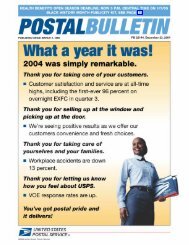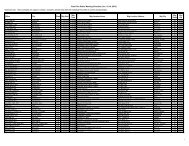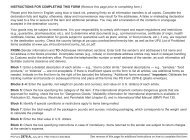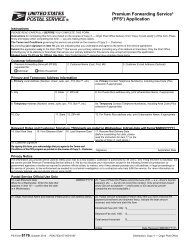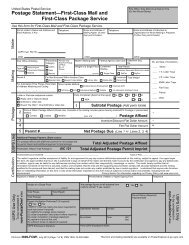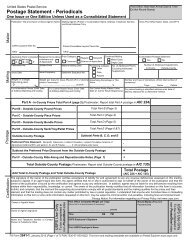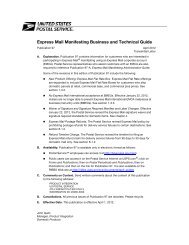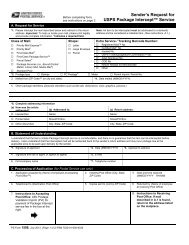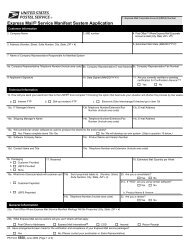2010 Comprehensive Statement on Postal Operations - USPS.com
2010 Comprehensive Statement on Postal Operations - USPS.com
2010 Comprehensive Statement on Postal Operations - USPS.com
You also want an ePaper? Increase the reach of your titles
YUMPU automatically turns print PDFs into web optimized ePapers that Google loves.
The <str<strong>on</strong>g>2010</str<strong>on</strong>g> Annual Performance Report and 2011 Annual Performance Plan<br />
DELIVERIES PER WORK HOUR<br />
The total number of deliveries is the product of the number of<br />
delivery points (approximately 151 milli<strong>on</strong>) multiplied by the number<br />
of delivery days (303). The result is approximately 45,753 milli<strong>on</strong><br />
deliveries. This is divided by the total number of work hours used<br />
in all employee categories, including managers and executives<br />
(1,134 milli<strong>on</strong>). The result is the number of annual deliveries<br />
<strong>com</strong>pleted per work hour used.<br />
<str<strong>on</strong>g>2010</str<strong>on</strong>g> Plan <str<strong>on</strong>g>2010</str<strong>on</strong>g> Result 2011 Plan<br />
N/A 38.6 deliveries 40.4 deliveries<br />
The 2011 plan of 40.4 deliveries per work hour is very aggressive.<br />
Since 2008, the number of deliveries per work hour has increased<br />
from 32.9 (2008) to 36.0 (2009) to 38.6 (<str<strong>on</strong>g>2010</str<strong>on</strong>g>). This performance<br />
is primarily the result of unprecedented work hour reducti<strong>on</strong>s and<br />
process improvements over this period.<br />
The ability to meet this objective will depend <strong>on</strong> further automati<strong>on</strong>,<br />
driving disciplined process improvement in all aspects of the<br />
business, and achieving more extensive c<strong>on</strong>solidati<strong>on</strong> of facilities.<br />
The <strong>Postal</strong> Service will c<strong>on</strong>tinue to engage employees in all functi<strong>on</strong>s<br />
in the drive to improve processes, making them better, faster, and<br />
more efficient. Lean Six Sigma, a structured regimen for eliminating<br />
n<strong>on</strong>-value activities, will c<strong>on</strong>tinue to be the main framework of<br />
process improvement efforts. Ongoing work to adopt requirements<br />
of the Sarbanes-Oxley Act (SOX) is also uncovering opportunities to<br />
improve efficiency.<br />
This <strong>Postal</strong> Service will also c<strong>on</strong>tinue to capture opportunities<br />
through employee attriti<strong>on</strong>. Up to 300,000 employees will be eligible<br />
to retire between now and 2020. As they leave, managers will<br />
repositi<strong>on</strong> employees to make full use of existing resources and<br />
minimize new hires.<br />
Opportunities to reduce work hours exist in all postal areas as<br />
opportunities are created by improved work methods, c<strong>on</strong>solidati<strong>on</strong>,<br />
and workload reducti<strong>on</strong>. The <strong>Postal</strong> Service is also closely examining<br />
opportunities in administrati<strong>on</strong>, which includes more than six percent<br />
of total work hours.<br />
Financial Measurement Details<br />
Operating In<strong>com</strong>e measures the net of total operating revenue minus<br />
operating expenses. Operating expenses excludes the prefunding<br />
of future retiree health benefits and n<strong>on</strong>-cash changes to the<br />
Workers’ Compensati<strong>on</strong> liability that results from changes to interest<br />
rates or actuarial assumpti<strong>on</strong>s. The additi<strong>on</strong> of Operating In<strong>com</strong>e<br />
as a corporate indicator will focus attenti<strong>on</strong> <strong>on</strong> the importance of<br />
profitability and cash flow that is within management’s c<strong>on</strong>trol.<br />
To measure in<strong>com</strong>e and all other aspects of financial performance,<br />
the <strong>Postal</strong> Service employs a disciplined process c<strong>on</strong>forming to the<br />
rigorous requirements of SOX. Accounting systems and financial<br />
reports are independently audited. Financial and accounting<br />
programs are also subject to audit by the Office of Inspector General<br />
and the Government Accountability Office, and financial procedures<br />
are protected against abuse by the <strong>Postal</strong> Inspecti<strong>on</strong> Service.<br />
The <strong>Postal</strong> Service’s fundamental financial objective is to generate<br />
in<strong>com</strong>e sufficient to fully fund operati<strong>on</strong>s and expand the delivery<br />
network, while c<strong>on</strong>tinuing to invest in improvements for the future.<br />
Since creati<strong>on</strong> of the modern <strong>Postal</strong> Service in 1970, postage prices<br />
have increased at about the rate of inflati<strong>on</strong>, despite large increases<br />
in costs such as fuel and health care. <strong>Postal</strong> Service prices are lower<br />
than most foreign posts, often dramatically so, even though the<br />
United States is larger and more geographically diverse than most.<br />
Deliveries per Work Hour is an efficiency measure that <strong>com</strong>pares<br />
the number of deliveries of all types (city, rural, highway c<strong>on</strong>tract<br />
route, Post Office Box, and Caller Service) with the total number<br />
of work hours used in all employee categories, including all field<br />
and headquarters managers, executives, and officers — even the<br />
postmaster general. This measure gets to the root of the challenges<br />
to the postal business model — the growing number of delivery<br />
points with declining mail volume.<br />
This replaces TFP, which is solely an aggregate measure and not as<br />
useful for managing and motivating performance, which is a primary<br />
functi<strong>on</strong> of the Annual Performance Plan. Compared with TFP,<br />
Deliveries per Work Hour is a more basic measure of productivity<br />
while being a more versatile tool for managing productivity<br />
performance at functi<strong>on</strong>al and unit levels. TFP is a very technical<br />
measure that cannot easily be understood by n<strong>on</strong>-specialists,<br />
and can also vary widely <strong>on</strong> an annual basis. It is best used for<br />
measuring trends over several years. The <strong>Postal</strong> Service will c<strong>on</strong>tinue<br />
to measure and use TFP where it is appropriate.<br />
<str<strong>on</strong>g>2010</str<strong>on</strong>g> Performance Report and 2011 Performance Plan | 7




